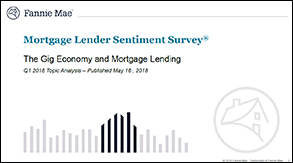How Will the Gig Economy Shape Mortgage Lending? Perspectives - May 16, 2018

On-demand gig economy services such as transportation, lodging, food/goods delivery, and personal task services are growing and reshaping how we think about work and self-employment.1 Our National Housing Survey® found that nearly one-fifth of American adults have provided a service through the gig economy.2 Because of the "on-demand" nature, the income stream can be less stable. With the rise of the gig economy, Fannie Mae's Economic & Strategic Research (ESR) Group surveyed senior mortgage executives through its quarterly Mortgage Lender Sentiment Survey® to understand lenders' views about using gig economy income in mortgage underwriting.
Survey findings include:
- 71 percent of lenders say that they have had borrowers apply for a mortgage with gig economy income over the past year.
- 89 percent expect the number of borrowers who would want to use gig economy income to qualify for mortgage loans to grow in the next few years.
- 68 percent think accepting gig economy income will help low- to moderate-income consumers access mortgage credit.
- 95 percent think it is difficult to use gig economy income to approve mortgage applications with today's lending practices. Top barriers include unpredictability and instability of gig economy income, investor requirements, and underwriting criteria standardization.
- 69 percent of lenders say current underwriting guidelines for self-employment income verification are about right, while 24 percent suggest easing existing standards.
Given the growth of the gig economy and its impact on how self-employed people work and earn income, the inclusion of gig worker income for mortgage underwriting should not be overlooked. Borrowers with a sufficient income history that fit within investors' guidelines are being served today, but a majority of lenders say that it is difficult to underwrite a mortgage loan with gig economy income due to its instability and unpredictability. This very nature of gig economy income makes it difficult to meet investor requirements, although most lenders believe that the current underwriting standards for self-employed borrowers are about right.
To make home financing more accessible to gig economy workers, we see the potential for new tools that could help verify and assess their income. For example, emerging technologies such as application program interfaces (APIs) and artificial intelligence could automate the verification of gig income from tax returns, payroll information, and bank statements, and help to assess income stability and predictability. Understanding how gig income borrowers and other self-employed borrowers are paid and how they report their income on their tax returns could help inform ways to streamline the verification and risk assessment process. Such future improvements fit into the bigger goals of improving the loan origination process and enhancing the borrower experience by minimizing tedious manual processes.
To learn more, read our Fannie Mae Q1 2018 Mortgage Lender Sentiment Survey Topic Analysis.
Jude Landis and Malloy Evans, Vice Presidents
Single-Family Mortgage Business
May 16, 2018
The authors thank Anthony Cole, Jon Lawless, Noelle Melton, Thomas Seidenstein, Doug Duncan, Steve Deggendorf, Khristina Waters, Carol Bell, and Li-Ning Huang for valuable comments in the creation of this commentary and the design of the topic analysis questions. Of course, all errors and omissions remain the responsibility of the author.
Opinions, analyses, estimates, forecasts and other views of Fannie Mae's Economic & Strategic Research (ESR) Group or of survey respondents reflected in this commentary should not be construed as indicating Fannie Mae's business prospects or expected results, are based on a number of assumptions, and are subject to change without notice. How this information affects Fannie Mae will depend on many factors. Although the ESR group bases its opinions, analyses, estimates, forecasts and other views on information it considers reliable, it does not guarantee that the information provided in this commentary is accurate, current or suitable for any particular purpose. Changes in the assumptions or the information underlying these views could produce materially different results. The analyses, opinions, estimates, forecasts and other views published by the ESR group represent the views of that group as of the date indicated and do not necessarily represent the views of Fannie Mae or its management.
1 Gig-economy workers tend to have flexible work arrangements, working on single projects or tasks, commonly on demand. Examples include transportation (e.g., Uber and Lyft), lodging rental (e.g., Airbnb and VRBO), food/goods delivery (e.g., Postmates), and personal task services (e.g., TaskRabbit). Fannie Mae does not endorse these companies. These examples do not represent the whole sector of gig economy. These are provided as examples to help illustrate what "gig economy" is referred to.
2 "More people Work in the Gig Economy Than You Might Think" (December, 2017), National Housing Survey, https://www.fanniemae.com/portal/research-insights/perspectives/gig-economy-homeownership-120517.html
Full research report "Gig Economy Workers and Homeownership" can be found at: https://www.fanniemae.com/resources/file/research/housingsurvey/pdf/dec2017-topic-analysis-presentation-gig-economy.pdf

